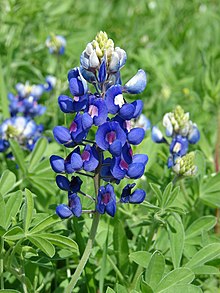Lupinus texensis
| Lupinus texensis | |
|---|---|
 |
|
| Scientific classification | |
| Kingdom: | Plantae |
| (unranked): | Angiosperms |
| (unranked): | Eudicots |
| (unranked): | Rosids |
| Order: | Fabales |
| Family: | Fabaceae |
| Subfamily: | Faboideae |
| Tribe: | Genisteae |
| Genus: | Lupinus |
| Species: | L. texensis |
| Binomial name | |
|
Lupinus texensis Hook. |
|
Lupinus texensis, the Texas lupine or Texas bluebonnet, is a species of lupine endemic to Texas. With other related species of lupines also called bluebonnets, it is the state flower of Texas.
It is an annual which begins its life as a small, gravel-like seed. The seed has a hard seed coat that must be penetrated by wind, rain, and weather over the course of a few months (but sometimes several years). In the fall, the bluebonnets emerge as small seedings with two cotyledons, and later a rosette of leaves that are palmately compound with 5-7 leaflets 3-10 cm long, green with a faint white edge and hair. Growth continues over the mild winter months and then in the spring will take off and rapidly grow larger, before sending up a 20-50 cm tall plume of blue flowers (with bits of white and occasionally a tinge of pinkish-red). The scent of these blossoms has been diversely described; many people say they give off no scent at all, while a few have described the scent as 'sickly sweet'.
It has been found in the wild with isolated mutations in other colors, most notably all-white flowers, pink, and maroon. These mutations have since been selectively bred to produce different color strains that are available commercially.
Texas recognizes all native lupine species occurring in the state as the official state flower. That fact leads to other species such as L. subcarnosus and L. havardii also being referred to as bluebonnets but there are distinctions among the species that differentiate them from L. texensis.
A Texas bluebonnet of the genus Lupinus
Texas bluebonnets in bloom
A field of Texas bluebonnets
...
Wikipedia
